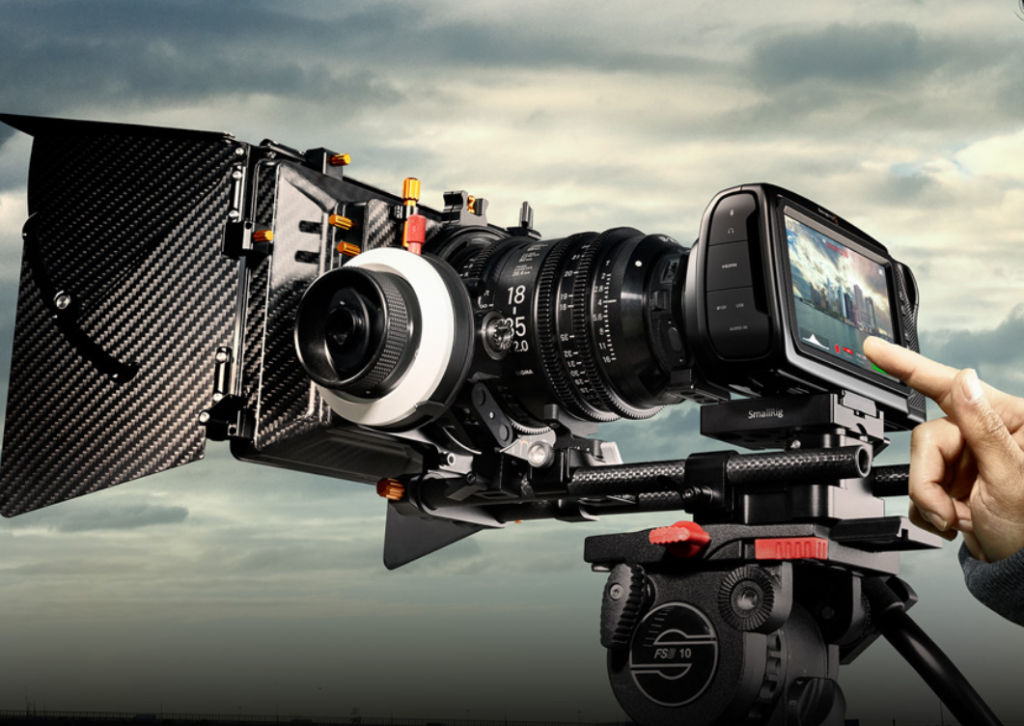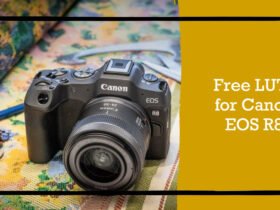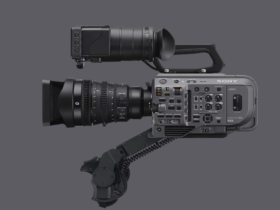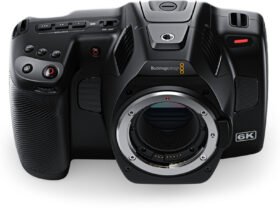Drawing from my own hands-on experience with various cameras, I can attest that the Sony FX3 has created quite a buzz among filmmakers, largely due to its outstanding capabilities. Yet, I’ve learned that no single cinema camera is a one-size-fits-all solution. From my time spent exploring and testing various models, I’ve come across several cinema cameras that can go toe-to-toe with the Sony FX3, or even surpass it in certain aspects. In this article, we will explore the top 3 Sony FX3 alternatives that are worth considering for anyone looking for a high-quality cinema camera that can deliver excellent results for their filmmaking needs.
1. Blackmagic Design Pocket Cinema Camera 6K Pro

If you are looking for a compact and versatile cinema camera, you might be interested in the Sony FX3 and the Blackmagic Pocket Cinema Camera 6K Pro. These are two of the most popular models in the market, but they have some significant differences that might affect your decision.
Sensor- Full frame or APSC
One of the main differences between the Sony FX3 and the Blackmagic Pocket Cinema Camera 6K Pro is the sensor size. The Sony FX3 has a 10.2MP full-frame CMOS Exmor R sensor, which offers high sensitivity, wide dynamic range, and low noise performance. The Blackmagic Pocket Cinema Camera 6K Pro has a 21.2MP Super35 sensor, which is slightly smaller than full-frame, but still delivers high resolution, rich colors, and 13 stops of dynamic range.
The sensor size affects the field of view, depth of field, and lens compatibility of the cameras. Generally, a full-frame sensor can capture a wider angle of view and a shallower depth of field than a Super35 sensor, given the same focal length and aperture. However, a Super35 sensor can also achieve a cinematic look with the right lenses and settings, and it can resolve more details with higher resolution.
Focus and Lens Mount
Another difference between the Sony FX3 and the Blackmagic Pocket Cinema Camera 6K Pro is the focus system and the lens mount. The Sony FX3 has a fast and reliable autofocus system, with phase-detection AF, face tracking, eye AF, and touch focus. It also has a E-mount, which is compatible with a wide range of lenses from Sony. The Blackmagic Pocket Cinema Camera 6K Pro does not have a reliable autofocus system, and it relies on manual focus or external follow focus devices. It has an EF mount, which is compatible with many Canon lenses and third-party lenses with adapters.
The focus system and the lens mount affect the usability and versatility of the cameras. The Sony FX3 is more suitable for situations where you need to quickly and accurately focus on moving subjects, such as documentary, sports, or wildlife. The Blackmagic Pocket Cinema Camera 6K Pro is more suitable for situations where you have more control over the focus, such as narrative, commercial, or music video. The lens mount also determines the availability and cost of the lenses you can use with the cameras.
Design- Dimension and Weight Comparison
The Sony FX3 and the Blackmagic Pocket Cinema Camera 6K Pro have different designs, dimensions, and weights. The Sony FX3 is more compact and lightweight, measuring 129.7 x 77.8 x 84.5 mm and weighing 640 g. It has a minimalist and ergonomic design, with a detachable handle that provides two XLR/TRS inputs and a hot shoe. It also has a weather-sealed body, a sensor shift stabilization system, and a timelapse function. The Blackmagic Pocket Cinema Camera 6K Pro is larger and heavier, measuring 180 x 101 x 96 mm and weighing 1.24 kg. It has a boxy and modular design, with an optional viewfinder that attaches to the hot shoe. It also has built-in ND filters, a larger battery, and a 12-bit RAW recording option.
The design, dimension, and weight of the cameras affect the portability and operability of the cameras. The Sony FX3 is easier to carry and handle, especially for handheld and gimbal work. It also offers more protection and stability for outdoor and challenging environments. The Blackmagic Pocket Cinema Camera 6K Pro is more bulky and heavy, requiring more accessories and support devices. It also offers more flexibility and quality for indoor and controlled environments.
Monitor
The Sony FX3 and the Blackmagic Pocket Cinema Camera 6K Pro have different types and sizes of monitors. The Sony FX3 has a 3-inch tilting touchscreen LCD with 1.44 million dots of resolution. It can be flipped out and rotated to various angles, making it convenient for vlogging, selfie, or low-angle shots. It also has a high brightness of 1500 nits, making it visible in bright sunlight. The Blackmagic Pocket Cinema Camera 6K Pro has a 5-inch tilting touchscreen LCD with 2.76 million dots of resolution. It can only be tilted up and down, limiting its usability for some shots. It also has a high brightness of 1500 nits, making it visible in bright sunlight.
The monitor type and size affect the visibility and functionality of the cameras. The Sony FX3 has a smaller but more flexible monitor, which can be adjusted to different positions and orientations. The Blackmagic Pocket Cinema Camera 6K Pro has a larger but less flexible monitor, which can only be tilted up and down.
Battery
The Sony FX3 and the Blackmagic Pocket Cinema Camera 6K Pro have different types and capacities of batteries. The Sony FX3 uses the NP-FZ100 battery, which has a capacity of 2280 mAh. It can record up to 95 minutes of 4K video with one charge, and it can be charged via USB-C or an external battery charger. The Blackmagic Pocket Cinema Camera 6K Pro uses the NP-F570 battery, which has a capacity of 3500 mAh. It can record up to 60 minutes of 6K video with one charge, and it can be charged via USB-C or an external battery charger.
The battery type and capacity affect the battery life and charging options of the cameras. The Sony FX3 has a lower capacity but longer battery life than the Blackmagic Pocket Cinema Camera 6K Pro, due to its lower resolution and power consumption. The Blackmagic Pocket Cinema Camera 6K Pro has a higher capacity but shorter battery life than the Sony FX3, due to its higher resolution and power consumption.
Video Capabilities & Audio Inputs
The Sony FX3 and the Blackmagic Pocket Cinema Camera 6K Pro have different video capabilities and audio inputs. The Sony FX3 can record up to 4K UHD at 120 fps, or Full HD at 240 fps, in 10-bit 4:2:2 XAVC S-I or 16-bit RAW formats. It can also record in S-Log3, HLG, or S-Cinetone color profiles, offering 15+ stops of dynamic range and cinematic color science. It has two XLR/TRS inputs on the detachable handle, and a 3.5 mm mic input and a 3.5 mm headphone output on the body. The Blackmagic Pocket Cinema Camera 6K Pro can record up to 6K at 50 fps, or 2.8K at 120 fps, in 12-bit Blackmagic RAW or 10-bit ProRes formats. It can also record in Film, Extended Video, or Video color profiles, offering 13 stops of dynamic range and flexible color grading options. It has two mini-XLR inputs and a 3.5 mm mic input on the body, and a 3.5 mm headphone output on the side.
The video capabilities and audio inputs affect the quality and versatility of the cameras. The Sony FX3 has a lower resolution but higher frame rate and color depth than the Blackmagic Pocket Cinema Camera 6K Pro, offering smoother motion and richer colors. The Blackmagic Pocket Cinema Camera 6K Pro has a higher resolution but lower frame rate and color depth than the Sony FX3, offering more details and flexibility. The Sony FX3 has more audio inputs than the Blackmagic Pocket Cinema Camera 6K Pro, offering more options for external microphones and headphones.
Price (USD)
The Sony FX3 and the Blackmagic Pocket Cinema Camera 6K Pro have different prices in the US market. The Sony FX3 costs $3,898, while the Blackmagic Pocket Cinema Camera 6K Pro costs $2,535.
The price difference affects the affordability and value of the cameras. The Sony FX3 is more expensive than the Blackmagic Pocket Cinema Camera 6K Pro, but it also offers more features and performance. The Blackmagic Pocket Cinema Camera 6K Pro is cheaper than the Sony FX3, but it also has some limitations and drawbacks.
2. Canon EOS R5 C

If you are looking for a compact and versatile cinema camera, you might be interested in the Sony FX3 and the Canon EOS R5 C. These are two of the latest models in the market, but they have some significant differences that might affect your decision.
Sensor- Full frame or APSC
Both the Sony FX3 and the Canon EOS R5 C have full-frame sensors, which offer high sensitivity, wide dynamic range, and low noise performance. However, the Canon EOS R5 C has a higher resolution of 45MP, compared to the Sony FX3’s 10.2MP. This means that the Canon EOS R5 C can capture more details and crop more freely than the Sony FX3. The Canon EOS R5 C also has a higher color depth of 25.3 bits, compared to the Sony FX3’s 24 bits, which means that it can produce more accurate and nuanced colors.
Focus and Lens Mount
Another difference between the Sony FX3 and the Canon EOS R5 C is the focus system and the lens mount. The Sony FX3 has a fast and reliable autofocus system, with phase-detection AF, face tracking, eye AF, and touch focus. It also has an E-mount, which is compatible with a wide range of lenses from Sony. The Canon EOS R5 C also has a reliable autofocus system, with Dual Pixel CMOS AF II, EOS iTR AF X, eye AF, and animal AF. It has an RF mount, which is compatible with many Canon lenses and third-party lenses with adapters.
The focus system and the lens mount affect the usability and versatility of the cameras. The Sony FX3 and the Canon EOS R5 C both offer smooth and accurate focus performance, especially for moving subjects and video recording. The lens mount also determines the availability and cost of the lenses you can use with the cameras. The Sony E-mount has a larger selection of lenses, especially for cinema and video purposes, while the Canon RF mount has some advantages in terms of speed, quality, and innovation.
Design- Dimension and Weight Comparison
The Sony FX3 and the Canon EOS R5 C have different designs, dimensions, and weights. The Sony FX3 is more compact and lightweight, measuring 129.7 x 77.8 x 84.5 mm and weighing 640 g. It has a minimalist and ergonomic design, with a detachable handle that provides two XLR/TRS inputs and a hot shoe. It also has a weather-sealed body, a sensor shift stabilization system, and a timelapse function. The Canon EOS R5 C is larger and heavier, measuring 142 x 101 x 111 mm and weighing 770 g. It has a boxy and modular design, with an optional viewfinder that attaches to the hot shoe. It also has built-in ND filters, a larger battery, and a 12-bit RAW recording option.
The design, dimension, and weight of the cameras affect the portability and operability of the cameras. The Sony FX3 is easier to carry and handle, especially for handheld and gimbal work. It also offers more protection and stability for outdoor and challenging environments. The Canon EOS R5 C is more bulky and heavy, requiring more accessories and support devices. It also offers more flexibility and quality for indoor and controlled environments.
Monitor
The Sony FX3 and the Canon EOS R5 C have different types and sizes of monitors. The Sony FX3 has a 3-inch tilting touchscreen LCD with 1.44 million dots of resolution. It can be flipped out and rotated to various angles, making it convenient for vlogging, selfie, or low-angle shots. It also has a high brightness of 1500 nits, making it visible in bright sunlight. The Canon EOS R5 C has a 3.2-inch tilting touchscreen LCD with 2.1 million dots of resolution. It can only be tilted up and down, limiting its usability for some shots. It also has a high brightness of 1500 nits, making it visible in bright sunlight.
The monitor type and size affect the visibility and functionality of the cameras. The Sony FX3 has a smaller but more flexible monitor, which can be adjusted to different positions and orientations. The Canon EOS R5 C has a larger but less flexible monitor, which can only be tilted up and down.
Battery
The Sony FX3 and the Canon EOS R5 C have different types and capacities of batteries. The Sony FX3 uses the NP-FZ100 battery, which has a capacity of 2280 mAh. It can record up to 95 minutes of 4K video with one charge, and it can be charged via USB-C or an external battery charger. The Canon EOS R5 C uses the LP-E6NH battery, which has a capacity of 2130 mAh. It can record up to 60 minutes of 8K video with one charge, and it can be charged via USB-C or an external battery charger.
The battery type and capacity affect the battery life and charging options of the cameras. The Sony FX3 has a higher capacity but shorter battery life than the Canon EOS R5 C, due to its lower resolution and power consumption. The Canon EOS R5 C has a lower capacity but longer battery life than the Sony FX3, due to its higher resolution and power consumption.
Video Capabilities & Audio Inputs
The Sony FX3 and the Canon EOS R5 C have different video capabilities and audio inputs. The Sony FX3 can record up to 4K UHD at 120 fps, or Full HD at 240 fps, in 10-bit 4:2:2 XAVC S-I or 16-bit RAW formats. It can also record in S-Log3, HLG, or S-Cinetone color profiles, offering 15+ stops of dynamic range and cinematic color science. It has two XLR/TRS inputs on the detachable handle, and a 3.5 mm mic input and a 3.5 mm headphone output on the body. The Canon EOS R5 C can record up to 8K at 60 fps, or 4K at 120 fps, in 12-bit Cinema RAW Light or 10-bit XF-AVC formats. It can also record in C-Log3, PQ, or HLG color profiles, offering 14 stops of dynamic range and flexible color grading options. It has a 3.5 mm mic input and a 3.5 mm headphone output on the body, and an optional XLR adapter.
The video capabilities and audio inputs affect the quality and versatility of the cameras. The Sony FX3 has a lower resolution but higher frame rate and color depth than the Canon EOS R5 C, offering smoother motion and richer colors. The Canon EOS R5 C has a higher resolution but lower frame rate and color depth than the Sony FX3, offering more details and flexibility. The Sony FX3 has more audio inputs than the Canon EOS R5 C, offering more options for external microphones and headphones.
Price (USD)
The Sony FX3 and the Canon EOS R5 C have different prices in the US market. The Sony FX3 costs $3,898, while the Canon EOS R5 C costs $3,199.
3. Blackmagic Design Pocket Cinema Camera 4K

If you are looking for a compact and versatile cinema camera, you might be interested in the Sony FX3 and the Blackmagic Design Pocket Cinema Camera 4K. These are two of the most popular models in the market, but they have some significant differences that might affect your decision. In this article, we will compare the main features and specifications of these cameras and see how the Blackmagic Design Pocket Cinema Camera 4K can be a good alternative for the Sony FX3.
Sensor- Full frame or APSC
One of the main differences between the Sony FX3 and the Blackmagic Design Pocket Cinema Camera 4K is the sensor size. The Sony FX3 has a 10.2MP full-frame CMOS Exmor R sensor, which offers high sensitivity, wide dynamic range, and low noise performance. The Blackmagic Design Pocket Cinema Camera 4K has a 2.08MP Four Thirds CMOS sensor, which is slightly smaller than full-frame, but still delivers high resolution, rich colors, and 13 stops of dynamic range.
The sensor size affects the field of view, depth of field, and lens compatibility of the cameras. Generally, a full-frame sensor can capture a wider angle of view and a shallower depth of field than a Four Thirds sensor, given the same focal length and aperture. However, a Four Thirds sensor can also achieve a cinematic look with the right lenses and settings, and it can resolve more details with higher resolution.
Focus and Lens Mount
Another difference between the Sony FX3 and the Blackmagic Design Pocket Cinema Camera 4K is the focus system and the lens mount. The Sony FX3 has a fast and reliable autofocus system, with phase-detection AF, face tracking, eye AF, and touch focus. It also has an E-mount, which is compatible with a wide range of lenses from Sony. The Blackmagic Design Pocket Cinema Camera 4K does not have a reliable autofocus system, and it relies on manual focus or external follow focus devices. It has an MFT mount, which is compatible with many Micro Four Thirds lenses and third-party lenses with adapters.
The focus system and the lens mount affect the usability and versatility of the cameras. The Sony FX3 is more suitable for situations where you need to quickly and accurately focus on moving subjects, such as documentary, sports, or wildlife. The Blackmagic Design Pocket Cinema Camera 4K is more suitable for situations where you have more control over the focus, such as narrative, commercial, or music video. The lens mount also determines the availability and cost of the lenses you can use with the cameras.
Design- Dimension and Weight Comparison
The Sony FX3 and the Blackmagic Design Pocket Cinema Camera 4K have different designs, dimensions, and weights. The Sony FX3 is more compact and lightweight, measuring 129.7 x 77.8 x 84.5 mm and weighing 640 g. It has a minimalist and ergonomic design, with a detachable handle that provides two XLR/TRS inputs and a hot shoe. It also has a weather-sealed body, a sensor shift stabilization system, and a timelapse function. The Blackmagic Design Pocket Cinema Camera 4K is larger and heavier, measuring 178.1 x 96 x 85.5 mm and weighing 721 g. It has a boxy and modular design, with a multifunction handgrip that provides quick access to essential functions. It also has built-in microphones, a full-sized HDMI port, and a 12-bit RAW recording option.
The design, dimension, and weight of the cameras affect the portability and operability of the cameras. The Sony FX3 is easier to carry and handle, especially for handheld and gimbal work. It also offers more protection and stability for outdoor and challenging environments. The Blackmagic Design Pocket Cinema Camera 4K is more bulky and heavy, requiring more accessories and support devices. It also offers more flexibility and quality for indoor and controlled environments.
Monitor
The Sony FX3 and the Blackmagic Design Pocket Cinema Camera 4K have different types and sizes of monitors. The Sony FX3 has a 3-inch tilting touchscreen LCD with 1.44 million dots of resolution. It can be flipped out and rotated to various angles, making it convenient for vlogging, selfie, or low-angle shots. It also has a high brightness of 1500 nits, making it visible in bright sunlight. The Blackmagic Design Pocket Cinema Camera 4K has a 5-inch tilting touchscreen LCD with 2.76 million dots of resolution. It can only be tilted up and down, limiting its usability for some shots. It also has a high brightness of 1500 nits, making it visible in bright sunlight.
The monitor type and size affect the visibility and functionality of the cameras. The Sony FX3 has a smaller but more flexible monitor, which can be adjusted to different positions and orientations. The Blackmagic Design Pocket Cinema Camera 4K has a larger but less flexible monitor, which can only be tilted up and down.
Battery
The Sony FX3 and the Blackmagic Design Pocket Cinema Camera 4K have different types and capacities of batteries. The Sony FX3 uses the NP-FZ100 battery, which has a capacity of 2280 mAh. It can record up to 95 minutes of 4K video with one charge, and it can be charged via USB-C or an external battery charger. The Blackmagic Design Pocket Cinema Camera 4K uses the LP-E6N battery, which has a capacity of 1865 mAh. It can record up to 60 minutes of 4K video with one charge, and it can be charged via USB-C or an external battery charger.
The battery type and capacity affect the battery life and charging options of the cameras. The Sony FX3 has a higher capacity but shorter battery life than the Blackmagic Design Pocket Cinema Camera 4K, due to its lower resolution and power consumption. The Blackmagic Design Pocket Cinema Camera 4K has a lower capacity but longer battery life than the Sony FX3, due to its higher resolution and power consumption.
Video Capabilities & Audio Inputs
The Sony FX3 and the Blackmagic Design Pocket Cinema Camera 4K have different video capabilities and audio inputs. The Sony FX3 can record up to 4K UHD at 120 fps, or Full HD at 240 fps, in 10-bit 4:2:2 XAVC S-I or 16-bit RAW formats. It can also record in S-Log3, HLG, or S-Cinetone color profiles, offering 15+ stops of dynamic range and cinematic color science. It has two XLR/TRS inputs on the detachable handle, and a 3.5 mm mic input and a 3.5 mm headphone output on the body. The Blackmagic Design Pocket Cinema Camera 4K can record up to 4K DCI at 60 fps, or Full HD at 120 fps, in 12-bit Blackmagic RAW or 10-bit ProRes formats. It can also record in Film, Extended Video, or Video color profiles, offering 13 stops of dynamic range and flexible color grading options. It has a mini XLR input and a 3.5 mm mic input on the body, and a 3.5 mm headphone output on the side.
The video capabilities and audio inputs affect the quality and versatility of the cameras. The Sony FX3 has a lower resolution but higher frame rate and color depth than the Blackmagic Design Pocket Cinema Camera 4K, offering smoother motion and richer colors. The Blackmagic Design Pocket Cinema Camera 4K has a higher resolution but lower frame rate and color depth than the Sony FX3, offering more details and flexibility. The Sony FX3 has more audio inputs than the Blackmagic Design Pocket Cinema Camera 4K, offering more options for external microphones and headphones.
Price (USD)
The Sony FX3 and the Blackmagic Design Pocket Cinema Camera 4K have different prices in the US market. The Sony FX3 costs $3,898, while the Blackmagic Design Pocket Cinema Camera 4K costs $1,295.
The price difference affects the affordability and value of the cameras. The Sony FX3 is more expensive than the Blackmagic Design Pocket Cinema Camera 4K, but it also offers more features and performance. The Blackmagic Design Pocket Cinema Camera 4K is cheaper than the Sony FX3, but it also has some advantages in terms of resolution, battery life, and RAW recording.
- Also Read: Top 3 Sony FX9 Alternatives
- Also Read: Top 3 Sony a6100 Alternatives
- Also Read: Top 3 FUJIFILM INSTAX MINI EVO Alternatives









